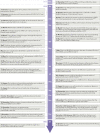The first 12 months of COVID-19: a timeline of immunological insights
- PMID: 33723416
- PMCID: PMC7958099
- DOI: 10.1038/s41577-021-00522-1
The first 12 months of COVID-19: a timeline of immunological insights
Abstract
Since the initial reports of a cluster of pneumonia cases of unidentified origin in Wuhan, China, in December 2019, the novel coronavirus that causes this disease - severe acute respiratory syndrome coronavirus 2 (SARS-CoV-2) - has spread throughout the world, igniting the twenty-first century's deadliest pandemic. Over the past 12 months, a dizzying array of information has emerged from numerous laboratories, covering everything from the putative origin of SARS-CoV-2 to the development of numerous candidate vaccines. Many immunologists quickly pivoted from their existing research to focus on coronavirus disease 2019 (COVID-19) and, owing to this unprecedented convergence of efforts on one viral infection, a remarkable body of work has been produced and disseminated, through both preprint servers and peer-reviewed journals. Here, we take readers through the timeline of key discoveries during the first year of the pandemic, which showcases the extraordinary leaps in our understanding of the immune response to SARS-CoV-2 and highlights gaps in our knowledge as well as areas for future investigations.
Conflict of interest statement
The Icahn School of Medicine at Mount Sinai has filed patent applications relating to SARS-CoV-2 serological assays and NDV-based SARS-CoV-2 vaccines, naming F.K. as co-inventor. The authors would also like to note the following, which could be perceived as a conflict of interest for F.K.: he has previously published work on influenza virus vaccines with S. Gilbert (University of Oxford), has consulted for Curevac, Merck and Pfizer (before 2020), is currently consulting for Avimex (Mexico) and Seqirus (Australia), his laboratory is collaborating with Pfizer on animal models of SARS-CoV-2, his laboratory is collaborating with N. Pardi at the University of Pennsylvania on mRNA vaccines against SARS-CoV-2, his laboratory was working in the past with GlaxoSmithKline on the development of influenza virus vaccines, and two of his mentees have recently joined Moderna. A.I. served as a consultant for Adaptive Biotechnologies. T.C. declares no competing interests.
Figures


Similar articles
-
SARS-CoV-2: Immune Response Elicited by Infection and Development of Vaccines and Treatments.Front Immunol. 2020 Dec 11;11:569760. doi: 10.3389/fimmu.2020.569760. eCollection 2020. Front Immunol. 2020. PMID: 33362758 Free PMC article. Review.
-
Escape from neutralizing antibodies by SARS-CoV-2 spike protein variants.Elife. 2020 Oct 28;9:e61312. doi: 10.7554/eLife.61312. Elife. 2020. PMID: 33112236 Free PMC article.
-
COVID-19: Unmasking Emerging SARS-CoV-2 Variants, Vaccines and Therapeutic Strategies.Biomolecules. 2021 Jul 6;11(7):993. doi: 10.3390/biom11070993. Biomolecules. 2021. PMID: 34356617 Free PMC article. Review.
-
How kids' immune systems can evade COVID.Nature. 2020 Dec;588(7838):382. doi: 10.1038/d41586-020-03496-7. Nature. 2020. PMID: 33303982 No abstract available.
-
Molecular Perspectives of SARS-CoV-2: Pathology, Immune Evasion, and Therapeutic Interventions.Mol Cells. 2021 Jun 30;44(6):408-421. doi: 10.14348/molcells.2021.0026. Mol Cells. 2021. PMID: 34059561 Free PMC article. Review.
Cited by
-
Changes in emergency department visits and mortality during the COVID-19 pandemic: a retrospective analysis of 956 hospitals.Arch Public Health. 2024 Jan 12;82(1):5. doi: 10.1186/s13690-023-01234-9. Arch Public Health. 2024. PMID: 38216989 Free PMC article.
-
A Prospective Multicenter Longitudinal Analysis of Suicidal Ideation among Long-COVID-19 Patients.Healthcare (Basel). 2024 Jan 23;12(3):290. doi: 10.3390/healthcare12030290. Healthcare (Basel). 2024. PMID: 38338174 Free PMC article.
-
The development of COVID-19 treatment.Front Immunol. 2023 Jan 26;14:1125246. doi: 10.3389/fimmu.2023.1125246. eCollection 2023. Front Immunol. 2023. PMID: 36776881 Free PMC article. Review.
-
Human NLRP1 is a sensor of pathogenic coronavirus 3CL proteases in lung epithelial cells.Mol Cell. 2022 Jul 7;82(13):2385-2400.e9. doi: 10.1016/j.molcel.2022.04.033. Epub 2022 May 16. Mol Cell. 2022. PMID: 35594856 Free PMC article.
-
SARS-CoV-2 spread to endocrine organs is associated with obesity: an autopsy study of COVID-19 cases.Endocrine. 2024 Jan;83(1):110-117. doi: 10.1007/s12020-023-03518-0. Epub 2023 Sep 12. Endocrine. 2024. PMID: 37698811 Free PMC article.
References
Publication types
MeSH terms
Substances
Supplementary concepts
Grants and funding
LinkOut - more resources
Full Text Sources
Other Literature Sources
Medical
Miscellaneous

